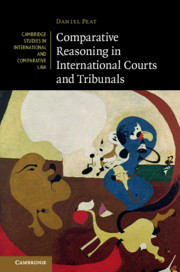Book contents
- Comparative Reasoning in International Courts and Tribunals
- Cambridge Studies in International and Comparative Law: 145
- Comparative Reasoning in International Courts and Tribunals
- Copyright page
- Contents
- Foreword
- Preface
- Table of Cases
- Table of Treaties
- Abbreviations
- 1 Introduction
- 2 The Limits of the Vienna Convention
- 3 Domestic Law in the Jurisprudence of the International Court of Justice
- 4 The Interpretation of Schedules of Commitments in the WTO
- 5 International Investment Law and the Public Law Analogy
- 6 Consensus Doctrine in the European Court of Human Rights
- 7 Domestic Law and System Building in the ICTY
- 8 Conclusion
- Bibliography
- Index
- Cambridge Studies in International and Comparative Law
6 - Consensus Doctrine in the European Court of Human Rights
Published online by Cambridge University Press: 24 May 2019
- Comparative Reasoning in International Courts and Tribunals
- Cambridge Studies in International and Comparative Law: 145
- Comparative Reasoning in International Courts and Tribunals
- Copyright page
- Contents
- Foreword
- Preface
- Table of Cases
- Table of Treaties
- Abbreviations
- 1 Introduction
- 2 The Limits of the Vienna Convention
- 3 Domestic Law in the Jurisprudence of the International Court of Justice
- 4 The Interpretation of Schedules of Commitments in the WTO
- 5 International Investment Law and the Public Law Analogy
- 6 Consensus Doctrine in the European Court of Human Rights
- 7 Domestic Law and System Building in the ICTY
- 8 Conclusion
- Bibliography
- Index
- Cambridge Studies in International and Comparative Law
Summary
The European Convention on Human Rights and Fundamental Freedoms (ECHR, or ‘the Convention’) was adopted in 1950 by 12 member states of the Council of Europe and entered into force three years later. The Convention was a direct response to the Second World War,2 and aimed to give effect to the rights enounced in the Universal Declaration of Human Rights, adopted by the UN General Assembly in 1948. The Convention and its associated 15 Protocols protect mainly the civil and political rights of citizens of the member states of the Council of Europe. These rights are enforceable by judicial procedure under Articles 33 and 34 of the Convention, which provide the European Court of Human Rights (ECtHR, or ‘the Court’) with jurisdiction over inter-state disputes and applications from aggrieved individuals, respectively.
- Type
- Chapter
- Information
- Comparative Reasoning in International Courts and Tribunals , pp. 140 - 177Publisher: Cambridge University PressPrint publication year: 2019

